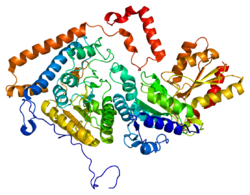1dtw: HUMAN BRANCHED-CHAIN ALPHA-KETO ACID DEHYDROGENASE
1ols: ROLES OF HIS291-ALPHA AND HIS146-BETA' IN THE REDUCTIVE ACYLATION REACTION CATALYZED BY HUMAN BRANCHED-CHAIN ALPHA-KETOACID DEHYDROGENASE
1olu: ROLES OF HIS291-ALPHA AND HIS146-BETA' IN THE REDUCTIVE ACYLATION REACTION CATALYZED BY HUMAN BRANCHED-CHAIN ALPHA-KETOACID DEHYDROGENASE
1olx: ROLES OF HIS291-ALPHA AND HIS146-BETA' IN THE REDUCTIVE ACYLATION REACTION CATALYZED BY HUMAN BRANCHED-CHAIN ALPHA-KETOACID DEHYDROGENASE
1u5b: Crystal structure of the human mitochondrial branched-chain alpha-ketoacid dehydrogenase
1v11: CROSSTALK BETWEEN COFACTOR BINDING AND THE PHOSPHORYLATION LOOP CONFORMATION IN THE BCKD MACHINE
1v16: CROSSTALK BETWEEN COFACTOR BINDING AND THE PHOSPHORYLATION LOOP CONFORMATION IN THE BCKD MACHINE
1v1m: CROSSTALK BETWEEN COFACTOR BINDING AND THE PHOSPHORYLATION LOOP CONFORMATION IN THE BCKD MACHINE
1v1r: CROSSTALK BETWEEN COFACTOR BINDING AND THE PHOSPHORYLATION LOOP CONFORMATION IN THE BCKD MACHINE
1wci: REACTIVITY MODULATION OF HUMAN BRANCHED-CHAIN ALPHA-KETOACID DEHYDROGENASE BY AN INTERNAL MOLECULAR SWITCH
1x7w: Crystal structure of the human mitochondrial branched-chain alpha-ketoacid dehydrogenase
1x7x: Crystal structure of the human mitochondrial branched-chain alpha-ketoacid dehydrogenase
1x7y: Crystal structure of the human mitochondrial branched-chain alpha-ketoacid dehydrogenase
1x7z: Crystal structure of the human mitochondrial branched-chain alpha-ketoacid dehydrogenase
1x80: Crystal structure of the human mitochondrial branched-chain alpha-ketoacid dehydrogenase
2beu: REACTIVITY MODULATION OF HUMAN BRANCHED-CHAIN ALPHA-KETOACID DEHYDROGENASE BY AN INTERNAL MOLECULAR SWITCH
2bev: REACTIVITY MODULATION OF HUMAN BRANCHED-CHAIN ALPHA-KETOACID DEHYDROGENASE BY AN INTERNAL MOLECULAR SWITCH
2bew: REACTIVITY MODULATION OF HUMAN BRANCHED-CHAIN ALPHA-KETOACID DEHYDROGENASE BY AN INTERNAL MOLECULAR SWITCH
2bfb: REACTIVITY MODULATION OF HUMAN BRANCHED-CHAIN ALPHA-KETOACID DEHYDROGENASE BY AN INTERNAL MOLECULAR SWITCH
2bfc: REACTIVITY MODULATION OF HUMAN BRANCHED-CHAIN ALPHA-KETOACID DEHYDROGENASE BY AN INTERNAL MOLECULAR SWITCH
2bfd: REACTIVITY MODULATION OF HUMAN BRANCHED-CHAIN ALPHA-KETOACID DEHYDROGENASE BY AN INTERNAL MOLECULAR SWITCH
2bfe: REACTIVITY MODULATION OF HUMAN BRANCHED-CHAIN ALPHA-KETOACID DEHYDROGENASE BY AN INTERNAL MOLECULAR SWITCH
2bff: REACTIVITY MODULATION OF HUMAN BRANCHED-CHAIN ALPHA-KETOACID DEHYDROGENASE BY AN INTERNAL MOLECULAR SWITCH
2j9f: HUMAN BRANCHED-CHAIN ALPHA-KETOACID DEHYDROGENASE-DECARBOXYLASE E1B




























